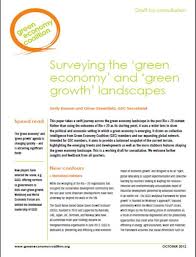Surveying the ‘green economy’ and ‘green growth’ landscape post Rio+20 (Green Economy Coalition)
Emily Benson and Oliver Greenfield (Green Economy Coalition) / September 2012
 This briefing looks at the work and perspectives of a diverse range of actors on the green economy after the Rio+20 conference held in June 2012.
This briefing looks at the work and perspectives of a diverse range of actors on the green economy after the Rio+20 conference held in June 2012.
Read article
There is on-going debate about what the ‘green economy’ and ‘green growth’ mean. This briefing concludes ‘green economy’ is more likely to include equity and poverty considerations whereas ‘green growth’ tends to have a narrower definition focused on growth at a time of economic recession.
The authors go on to say that governments are starting to use the idea of green growth but this may only focus on technology and business opportunities. Meanwhile the private sector is interested in ‘green growth’ because of potential market opportunities.
The final document agreed on at Rio+20 included several areas that could be focused on: shift in production and consumption patterns, discussions on going beyond GDP and potential commitments for Sustainable Development Goals (SDGs).
Key global trends that will impact on the prospects for a green economy:
Eurozone crisis: low growth forecasts and reductions in overseas aid
Financial crisis: continuing demand for reform of financial system
Climate Change: food price rises due to severe drought and flooding
Shale gas: huge increase in fracking across the world
E7 to replace G7: Emerging economies (China, India etc) will be bigger that G7 economies by 2020.
Multilateral institutions
- Global Green Growth Institute (founded 2010) promoting ‘green growth planning’ in several developing countries
- World Bank Inclusive Green Growth report (May 2012) calls for focus on natural capital and welfare as part of green growth.
- Wealth Accounting and the Valuation of Ecosystem Services (WAVES) aims for governments to include the value of ecosystem services in their national accounts
- The Organization for Economic Co-operation and Development (OECD) Green Growth strategy focuses on resource efficiency, new markets and innovation.
- The United Nations Environment Programme (UNEP) Partnership for Action on Green Economy will bring together research and provide policy advice to governments.
- The United Nations Industrial Development Organisation (UNIDO) has convened the Green Industry Platform to ‘green’ manufacturing processes and create green industries for production of goods and services for domestic use or export.
- The International Labour Organisation (ILO) believes up to 60 million Green Jobs can be created.
- The Global Green Growth Knowledge Platform coordinates new research
Multilateral banks supporting green growth include: World Bank, African Development Bank, European Bank for Reconstruction and Development, Inter-American Development Bank and the European Investment Bank.
Governments
Leading proponents include South Korea, Denmark, UAE, Mexico, Germany, South Africa, Tanzania and Brazil.
The European Union’s 2020 strategy will encourage ‘green economic growth and create an inclusive society’.
China has committed US$140 billion on green investments between 2011 and 2015. China is the leading manufacturer of renewable energy in the world.
Several Latin American countries such as Venezuela, Ecuador and Bolivia strongly oppose the green economy and green growth. These countries promote the ‘rights of nature’ as an alternative development model and Bolivia recently passed a Law of Mother Earth.
Business and Industry
There are several signs the green economy idea is being taken on board. There is increasing investment in green research (by the automotive and semiconductor sectors), solar panel costs are falling and companies are implementing measures to become more sustainable. However, industry is mainly waiting to see what happens and what business case is made for a transition to a green economy.
Civil society
There are different levels of engagement on the green economy and this is partly down to continuing divisions within global civil society on:
- Whether an economic value should be put on the environment. Will instruments such as Payments for Ecosystem Services (PES) protect the environment or lead to its commodification and subsequent land grabs?
- Who will control the green economy? Will it be communities or large companies?
- Will green growth based on resource efficiency be inclusive and reduce poverty? Will a green economy reduce inequality?
- Will developed countries use the green economy to avoid drastic reductions in consumption?
Read article
————————————
This summary was prepared by Why Green Economy?. The views expressed have been paraphrased. See the original source for more information.

Leave a Reply